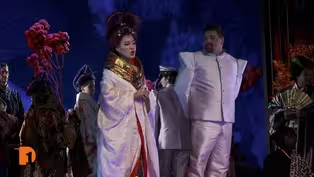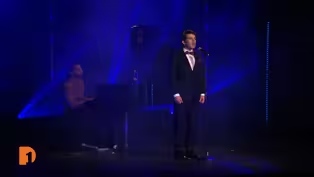
AAPI community reacts to Detroit Opera’s ‘Madame Butterfly’
Clip: Season 8 Episode 14 | 8m 1sVideo has Closed Captions
A conversation on AAPI representation, progress around Detroit Opera’s “Madame Butterfly.”
One Detroit’s Bill Kubota explores the historical representations in “Madame Butterfly” and how Detroit Opera’s new rendition addresses these cultural concerns with Jasmine Rivera, co-executive director of Rising Voices, filmmaker and graphic artist Chien-An Yuan, and Professor Mika Kennedy, an assistant professor at Ithaca College’s Center for the Study of Culture, Race and Ethnicity.
Problems playing video? | Closed Captioning Feedback
Problems playing video? | Closed Captioning Feedback
One Detroit is a local public television program presented by Detroit PBS

AAPI community reacts to Detroit Opera’s ‘Madame Butterfly’
Clip: Season 8 Episode 14 | 8m 1sVideo has Closed Captions
One Detroit’s Bill Kubota explores the historical representations in “Madame Butterfly” and how Detroit Opera’s new rendition addresses these cultural concerns with Jasmine Rivera, co-executive director of Rising Voices, filmmaker and graphic artist Chien-An Yuan, and Professor Mika Kennedy, an assistant professor at Ithaca College’s Center for the Study of Culture, Race and Ethnicity.
Problems playing video? | Closed Captioning Feedback
How to Watch One Detroit
One Detroit is available to stream on pbs.org and the free PBS App, available on iPhone, Apple TV, Android TV, Android smartphones, Amazon Fire TV, Amazon Fire Tablet, Roku, Samsung Smart TV, and Vizio.
Providing Support for PBS.org
Learn Moreabout PBS online sponsorship- [Will] Detroit Opera's fresh interpretation of "Madame Butterfly," places the narrative of the beloved story in the hands of the artist of Asian descent.
One Detroit senior producer, Bill Kubota, sat down with members of the local Asian American and Pacific Islander community to talk about the historical representations in "Madame Butterfly," and how the Detroit Opera production, addresses these cultural concerns.
(bright upbeat music) - Let's talk more about Opera, "Madame Butterfly," and even more from an AAPI point of view.
We're talking with Dr. Mika Kennedy at Ithaca College, specializing in Asian American studies, and we've been connected with Twitter for a long time here in Southeastern Michigan.
We're with Jasmine Rivera with Rising Voices, advocating for Asian American women in Michigan, also a director of stage and screen.
And we're also with Chien-An Yuan, artist, educator, filmmaker, and contributor to One Detroit.
Thanks for turning on your cameras.
Let's talk about "Madame Butterfly," an opera set in Japan that goes back 120 years or so, but this one playing here in Detroit comes from a Japanese and Japanese-American creative team.
What do you all think of that?
- Well, I think, it's extraordinary.
You know, as an Asian American woman and artist, when you hear "Madame Butterfly" being mentioned, you kind of get a knee-jerk gut reaction to it, which is wholly negative for many reasons.
But when you discover for this particular production that the creative team is Japanese and Japanese-American, and is coming from their sort of interpretation of it, then it's exciting to see what they could do to subvert a piece of artwork that has been so problematic, and has led to many, many issues that have bled into our culture.
So it's very intriguing.
- The classical music world, especially, the opera world in the United States, needs a refresher.
You know, and these kind of innovative stagings, these axle reclamation, especially, for AAPI artists, as Jasmine said, "Madame Butterfly" is notorious amongst works of art depicting Asian representation.
And I just think that the fact that they're rethinking it, that they're reclaiming a lot of the issues that directly in this production, I think, is a brave and necessary thing to do.
And it has been a long time coming.
- Mika, I suspect that you've heard of some of these issues that have come up.
I guess, they've been with us all our lives in one form or another, and that other adaptations that came along more recently.
- I am someone who has actually never seen a traditional version of "Madame Butterfly," so I've only read it in summaries of the acts.
And so my background for it actually comes from David Henry Hwang's "M. Butterfly," which is a stage play that is also kind of doing some of that subversive work a little bit differently, 'cause it's a play, and kind of takes its own storyline in its own kind of historical moment.
But it's interesting to come back to a version that's closer to the original, and still see what kinds of opportunities for conversation that can open when we're still using Puccini's original music.
We're still using the outperform and doing really interesting things with it.
- Regarding this particular program, has this virtual reality element to it then, was that surprising to you or did that seem like this the way a lot of these things are going?
- Yeah, I think, it was actually really interesting because so much of "Madame Butterfly" now is really about, like, the modern reading of it is about fantasy.
You know, that it is the ultimate Western male fantasy of an "Orientalist" fantasy of what a romance with an Asian woman would be like.
Framing it as virtual reality.
They really embrace that idea of it being a fantasy, you know, like a vision as opposed to anything real.
It's like, for anybody who knows this story, you're like, you know, this 15 year old girl, gives her whole life for this guy who kind of sucks, you know, and you realize at the end that she has her own power with within this staging.
And it was genuinely refreshing - These kind of ideals that power "Madame Butterfly," are still very much part of society.
I should probably revise that statement and say that they're part of society, but they also continue to be reinvented.
And so there's new and different versions of them based on what is happening in our culture today.
And so there's a concept that I did not invent called Techno Orientalism, and it is that revision of the original 19th century, early 20th century vision of the Orient as something that's exotic, something that's consumable.
And the Techno Orientalism takes that idea into the sci-fi element, the speculative, the futuristic, similar to this concept of virtual reality.
And so when I look at this production of "Madame Butterfly," it's really kind of taking two things to task.
It's taking the original fantasies that animate Puccini's "Madame Butterfly," and also the fantasies that animate this concept of Techno Orientalism, and this association with Asianness and something that is somehow culturally primitive but also technologically advanced.
And so we see it in things like "Blade Runner," and we see it in things like "Star Wars," or things like "Firefly," where there's this kind of Asiatic sense to what the future will look like.
That often kind of ends up, what's the word, I guess, tumble weeding into these yellow pair fears of an Asian takeover.
And so when we look at virtual reality in this production of "Madame Butterfly," we're also looking at the fantasy of the virtual, the fantasy of that association with kind of an Asian-dressed future that may or may not actually include actual Asian bodies.
- What any other comments or ideas here that we ought to add to this?
- I do wanna talk about the fact that you have this creative team, and the rising presence of Asian Americans across culture and media.
And so you have a work of art that was made by a non-Asian composer and writers, and that was taken on by this team and reinterpreted for today.
And it was done in a way that was very thoughtful, and it required a lot of engagement.
I know from things that I've read in interviews by Matthew Ozawa, the director, this was an uncomfortable process for himself as an Asian American man to engage with this sort of material.
But also he felt the need to do so because it was important, and it was part of his sort of process as an artist to find his own identity in figuring this project out.
And so I think it's very important to emphasize the need for making space for Asian American creators in these historically white art forms.
- Well, I think, to recognize too is that "Madame Butterfly" as a opera work isn't going anywhere because the music is that beautiful and "Un Bel Di" is one of the most famous like soprano aria.
So it's not going anywhere, even though I would love for it to disappear for a while.
But the fact that it's not going anywhere, it's critical that it goes to what Jasmine is saying is that very much like, if it's not going anywhere, let's put it in the hands of Asian American or Asian creators and see what happens, and see how they they engage with it.
Because otherwise, you're still gonna end up with something really antiquated and offensive, deservingly offensive.
AAPI-led creative team re-imagines ‘Madame Butterfly’ opera
Video has Closed Captions
Clip: S8 Ep14 | 8m 9s | Detroit Opera re-imagines “Madame Butterfly” with an Asian American creative team. (8m 9s)
FAR Therapeutic kicks off ‘Detroit Performs’ season 13
Video has Closed Captions
Clip: S8 Ep14 | 3m 11s | FAR Therapeutic client Leo Palmer sings “In My Shoes” on “Detroit Performs.” (3m 11s)
One Detroit Weekend: October 6, 2023
Video has Closed Captions
Clip: S8 Ep14 | 1m 27s | Check out eight exciting events happening around metro Detroit on “One Detroit Weekend.” (1m 27s)
Providing Support for PBS.org
Learn Moreabout PBS online sponsorship
- News and Public Affairs

Top journalists deliver compelling original analysis of the hour's headlines.

- News and Public Affairs

FRONTLINE is investigative journalism that questions, explains and changes our world.












Support for PBS provided by:
One Detroit is a local public television program presented by Detroit PBS


